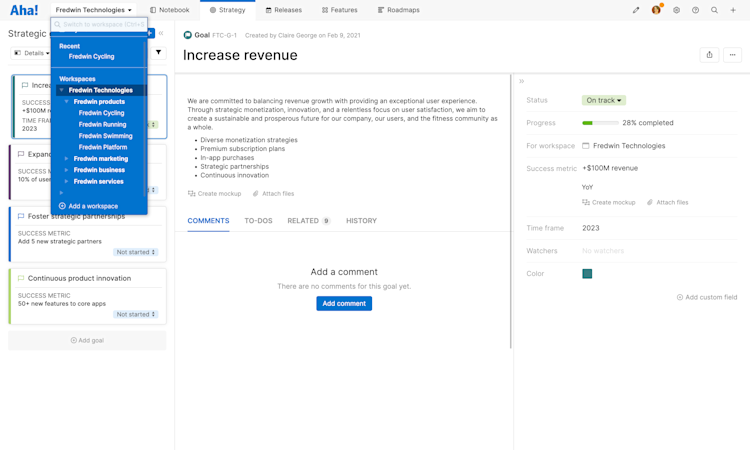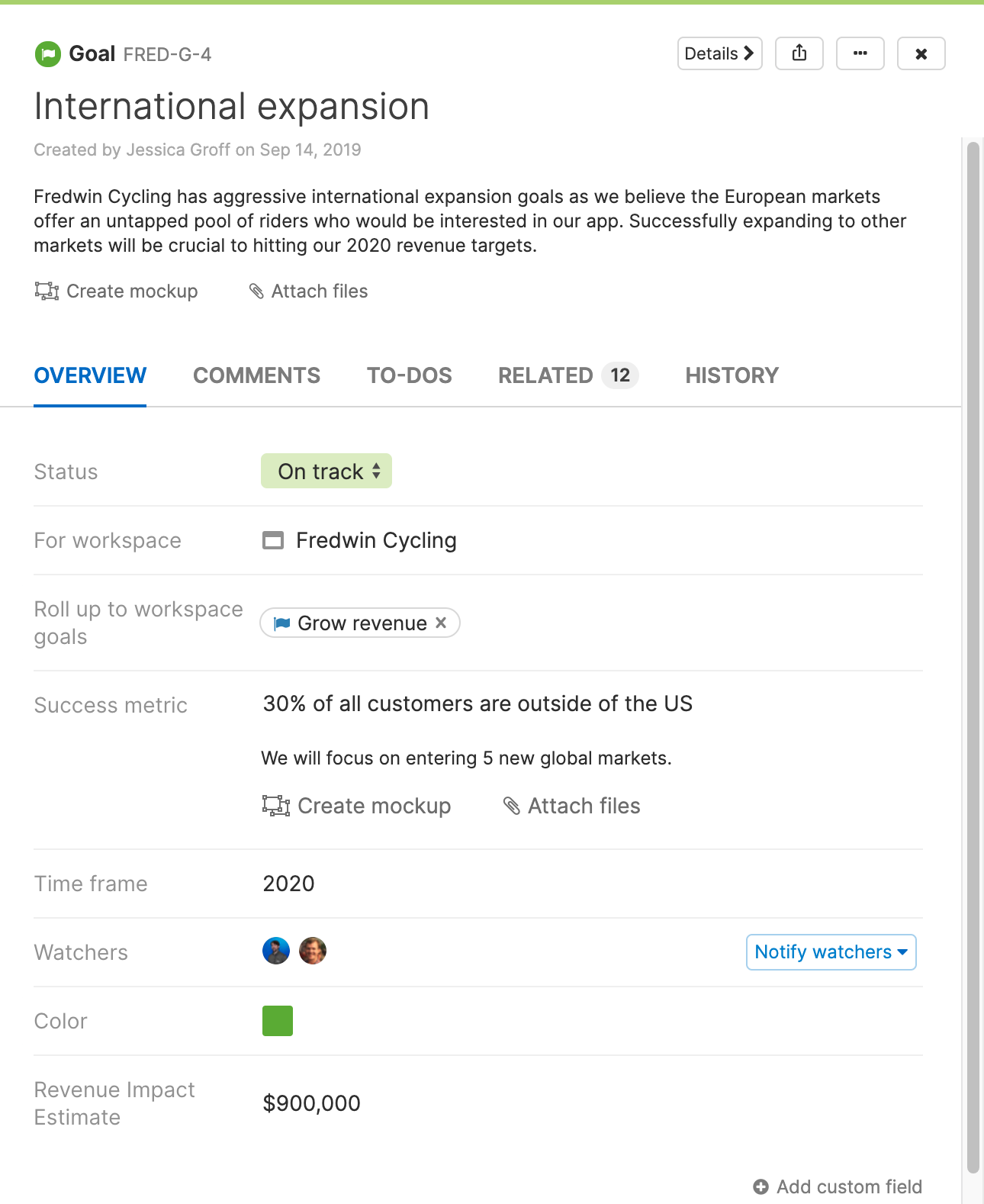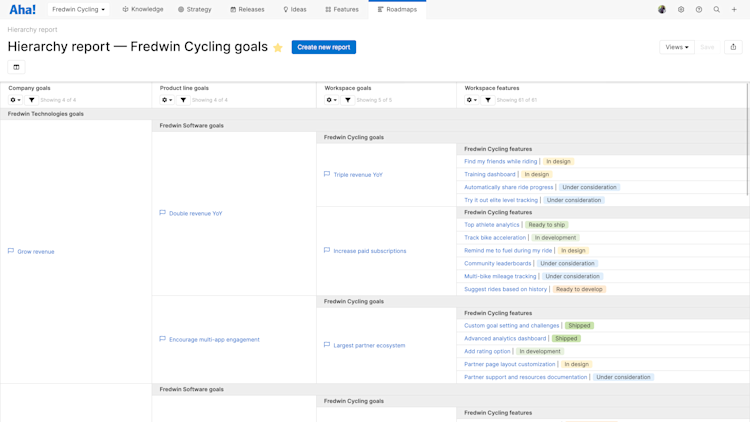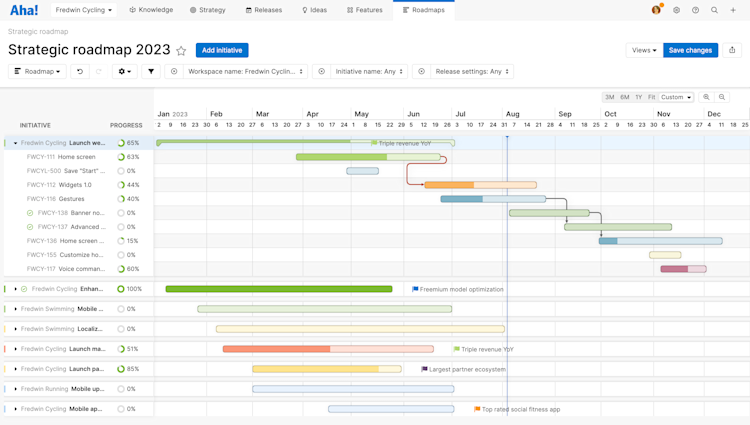Aha! Roadmaps | Best practices for linking your work to strategy
Setting a clear strategy is fundamental to building successful products. When you have a clear vision of what you want to achieve, then you can set goals and initiatives to guide the implementation of work. Establishing a goal-first framework ensures the entire organization stays focused on delivering the most customer and business value.
Strategic planning should follow a top-down approach that starts with overall business goals and then identifies supporting strategies at every level of your organization. In large companies, this can include rolling up strategy at multiple levels. These levels might include division, product line, and individual products as well as different business functions and teams. Ensuring organizational alignment between each level is vital for creating a unified plan. But it can be challenging to see how everything relates in a complex environment, especially if strategy is scattered across disparate tools.
Aha! Roadmaps provides a single place for capturing strategy and defining plans. The flexible workspace hierarchy lets you add as many levels as you need to represent the way your organization is structured. You can set goals and initiatives at each level of your hierarchy and create relationships between the levels. This makes it possible to link work within individual workspaces to strategy at the company level.
Everyone on our Customer Success team is an Aha! Roadmaps expert and former product manager. We work closely with some of the world’s largest and most sophisticated technology companies, helping teams weave what we call the "red thread of strategy" throughout their organization. The best practices outlined below will help you do just that — so you can deliver against your company's vision and empower teams to do their best work.
Click on any of the links below to learn how to use the specific functionality referenced:
Step 1: Structure your workspace hierarchy
You will want to align your workspace hierarchy with the way your organization sets strategy and implements work. For example, a small organization might only need two levels — the overall company and then the individual products or teams underneath it. A large enterprise typically needs additional levels that represent divisions and subdivisions.
Here is an example of how you can organize your hierarchy using workspace lines and workspaces to support a large organization. Of course, you can skip any levels that do not apply to you.
Company: Establish a workspace line at the top level of your hierarchy to represent your organization.
Division: Create as many additional workspace lines as you need underneath the company level to represent your business units or divisions.
Subdivision: Add workspace lines within each division to represent subdivisions or product lines. You might refer to these as "product suites," "product portfolios," or "families."
Individual products and projects: Add as many workspaces as you need within each subdivision to represent each product and service you deliver to customers. This is where you will prioritize work for implementation.
The screenshot below shows how a large software company might structure their hierarchy in the Aha! Roadmaps application:

You can also create workspace lines to represent different business functions. Choose the type of workspace that is best suited for the work you manage — such as IT, project management, business operations, and marketing. This is where cross-functional teams can track their schedules and activities.
Structuring your hierarchy in this way enables you to capture and connect strategy throughout your organization. We recommend giving each workspace line and workspace a unique name to reduce confusion when you bring information together from multiple workspaces in reports and roadmaps.
Step 2: Capture strategic imperatives
It is important to establish a consistent approach for setting strategy across your organization. Goals and initiatives are the primary Aha! Roadmaps record types used for capturing strategic imperatives. Goals are measurable results that are needed to achieve your strategic vision. Initiatives are the big efforts that help you accomplish those goals. Determine which record types you want to use at each level of your hierarchy and how these records relate to each other. To create that "red thread of strategy" mentioned earlier, you will want to establish roll-up relationships between goals and initiatives at each level of your hierarchy. A "roll up to workspace line" field is included by default on these record types.
This means, for example, you can link a division goal to a company goal or a workspace initiative to a sub-division initiative. We recommend customizing the record layout for goals and initiatives to make the "roll up to workspace line" field required. This will assure a consistent approach for strategic planning throughout your organization.

You can also tie initiatives directly to goals in Aha! Roadmaps — a great way to show how the high-level efforts you are planning will help you achieve your objectives. The table below provides an example of how to define strategy and create roll-up relationships for each level of the hierarchy described in step one.
Hierarchy level | Best practice | Roll-up relationships |
Company | Make sure you add a success metric and a time frame for each goal.Define the overall direction of the company, including your company vision and goals. | |
Division | Create an umbrella set of goals and initiatives at the division-level. These should align with the company-level goals and provide direction for portfolios of related products and services. |
|
Subdivision | Use this layer of strategic planning to define goals and initiatives for each suite or family of products. These should provide clarity for individual product planning. |
|
Workspace | Create goals and initiatives for each individual product and service. These should serve as a framework for planning releases and prioritizing features. |
|
Step 3: Connect work to strategy
Now that you have strategic alignment at every level of your organization, it is time to focus on the actual work that teams need to get done. Use the individual workspaces in your hierarchy to create and prioritize features within releases. Allow strategy to guide prioritization decisions by focusing on the features that best align with your goals and initiatives.
You will want to link the actual work to workspace goals and initiatives so you can clearly show how you will deliver against your strategy. We recommend creating guidelines for the team so everyone follows the same approach. Putting standards in place ensures data consistency so you can easily create roll-up reports showing how your strategy ties together.
For example, if all features contained within a release relate to the same initiative, then you might only want to link the overall release to the initiative. But let's imagine a release contains features that support multiple initiatives. Then it makes sense to link each feature to the right initiative. In the same way, if a work item is linked to an initiative, you do not need to link it directly to a goal. This is because you have already connected your initiatives to goals, establishing a clear roll-up relationship.

Step 4: Track progress
You are perfectly primed to start tracking progress against your strategy. Add a progress field to your goals, initiatives, releases, and features. Then, choose the most effective way to calculate progress for each record at each level of your hierarchy. As always, it helps to establish a consistent approach to tracking progress so you can quickly visualize progress on roadmaps and reports at any level of your organization.
Here are the ways we recommend you calculate progress across records types:
Workspace-line goals: Calculate from child goals
Workspace-line initiatives: Calculate from child initiatives
Workspace goals: Calculate from workspace initiatives
Workspace initiatives: Calculate from releases or features
Releases: Calculate the progress of releases from features
Features: Calculate the progress of features from requirements, remaining estimate, or to-dos.
You can set default progress calculation methods at the workspace level, and even inherit defaults from workspace lines.
We know that many engineering teams capture the percent of work completed in the development system. You can easily sync the progress field for features in Aha! Roadmaps with the progress field in Jira, Azure DevOps, and Rally.

Step 5: Report on progress towards your objectives
Use our powerful analytics capabilities to report against your strategy. The Aha! Roadmaps report builder makes it easy to quickly create the list reports, pivot tables, charts, and custom roadmaps you need. Or you can choose from more than 75 example reports to get started quickly. You can visualize multiple levels of your strategy in your reports. Create a list, pivot, chart, or custom roadmap to see a holistic view of how your work contributes to the overall strategy. You can report on up to six levels of goals and five levels of initiatives. Below are three examples of roadmaps and reports that will help you visualize how your strategy ties together across your organization.
Create a hierarchy report to visualize relationships across your goals, initiatives, releases, and features. This report is a great way to ensure that your strategy is linked correctly at each level of your hierarchy. Gaps in the report help you quickly identify records — such as releases or features — that are not yet linked to a strategic initiative so you ensure data consistency.

Use the strategy roadmap to visualize the timing and progress of initiatives. You can include initiatives across multiple workspace lines and workspaces in one view. You can also layer in the tactical work underway, displaying releases and features in the context of each initiative.

Create a pivot report for an in-depth view of your data. You can visualize information, control each column and row, and perform calculations on data sets. Here, we built a pivot table to show the status of features by goal and initiative. This makes it easy to show exactly how you are delivering against your strategy.

Empower your entire organization to move forward in alignment. If you need help configuring your account to capture strategy across your organization, contact us at support@aha.io. A member of our Customer Success team will respond to your request fast to help you get the most out of Aha! Roadmaps.